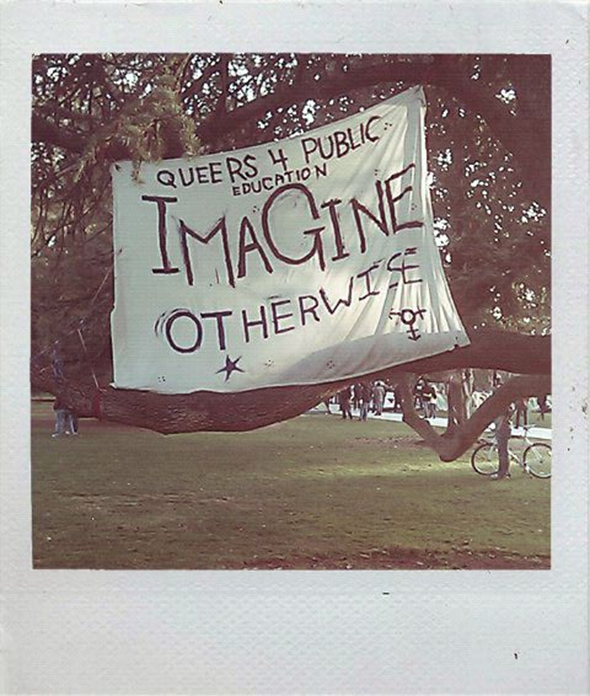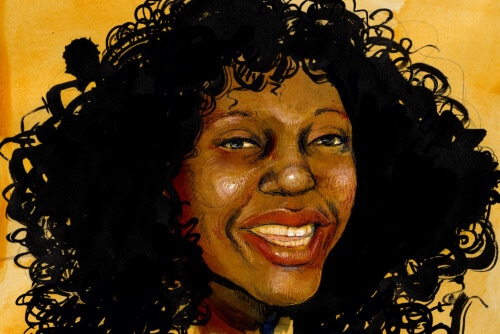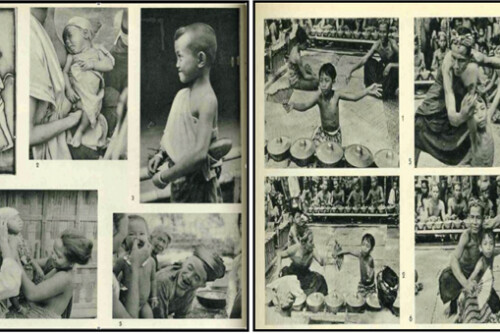A response to the panel “Using Knowledge, Advancing Activism” at the conference Activism and the Academy: Celebrating 40 Years of Feminist Scholarship and Action. Watch the video here:
As I was writing my comments for the Campus Activism panel at the 2011 Activism and the Academy Conference, I was aware of the historicity of the event. I knew I would be speaking at the physical site of the 1982 Scholar & Feminist conference where pro-sex feminists introduced critical new ways of imagining the politics of sexuality and desire; I knew I would be speaking alongside and in front of fierce scholar-activists whose contributions to queer and feminist thought I have admired for years; and I knew the event would be recorded for the BCRW website—a vital tool in many queer feminist classrooms (including my own). My awareness of the pasts and potential futures of the event made me all the more conscious of my words. Thus, when describing my experiences as a student and instructor at the University of California, Davis, I was especially careful to mark the 2009-2010 academic year as the most contentious and spectacular year of activism around the drive to privatize the University of California—so far—in order to avoid foreclosing what seemed, even then, to be the inevitability of future actions. An image that was projected behind me as I spoke showed mostly queer students of color at the March 4, 2010 international day of action in support of public education at UC Davis holding a banner that read, “Queers for Public Education.” I argued that the fact that a group of undergraduate student organizers chose to march under this sign at a nominally nonqueer event, and on the same day that a group of graduate students—Toby Beauchamp, Cynthia Degnan, Liz Montegary, and me—released an online statement entitled, “queers for public education,” suggested a queer ethos of campus activism. But what it meant to be a queer for public education was perhaps best expressed by the scores of handmade patches made by Liz’s upper-division queer theory class and worn by participants in the protest—scraps of fabric individually spray-painted with an image of a fist holding a pen and the words, “imagine otherwise.”

Just before the Campus Activism panel, as I sat and listened to the Using Knowledge, Advancing Activism panel, I couldn’t help but notice the way a similar sentiment was expressed by the panelists Rinku Sen, Jamia Wilson, and Dean Spade. Laura Flanders organized the panel around two central questions: Whose knowledge matters? What counts as knowledge? The resulting conversation included practical advice from seasoned organizers (for instance, Sen’s insistence that information isn’t power unless there is also action and Spade’s call for a reevaluation of activist strategies when we can’t simply depend on the triumph of some kind of moral state); insights gleaned from personal and family histories (including Sen’s story of coming to racial political consciousness through campus organizing and Wilson’s telling of her grandmother’s engagement with local media and the necessity of trusting one’s instincts); and a discussion of how knowledge production and pedagogical practice must occur both in conjunction with and as disconnected from the university (such as the efforts of both the Sylvia Rivera Law Project and the Applied Resource Center (now Race Forward) to generate tools for future organizing, and the use of Free Schools as alternative spaces of knowledge making and sharing).
I was especially struck by the closing portion of the panel conversation when Sen and Spade turned toward the importance of hope, imagination, and optimism in producing knowledge that advances social justice and a transformative vision of the future. After rightly challenging the supposition that the increasingly corporatized university will be the primary site for generating radical and critical thought (given its central role in the production of what he called “nightmarish, racist, eugenic information”), Spade argued that developing and inhabiting emancipatory activist knowledges must begin with a process of imagination. This process requires “opening up to the hope of possibility” and figuring out what kind of people “we have to be to be in a world where all that we imagine differently is even possible.” That is, the first step toward making the kinds of large-scale changes necessary for a more just world—changes such as the abolition of prisons and the provision of free and universal housing, education, and health care—will actually be the seemingly simple yet simultaneously terrifying effort of imagining a world that is currently unimaginable. It requires making big demands that contradict deeply held assumptions about property, personhood and the nation-state, which many of us have possessive investments in retaining. Sen added that even though the optimistic stance from which such demands must be made is often difficult to maintain in the face of what can feel like the never-ending onslaught of defeats and contravening information, the task for the organizer and radical thinker is to “fake it.” In order to challenge the neoliberal logics of expertise, inevitability, and capitalist progress that make big demands seem untenable we must be hopeful and retain the belief—however slight and however fabricated—that we can effect change. We must imagine the world otherwise.
In the final moments of the panel, three comments were made which proved prophetic in the months to come: Spade stressed the importance of a employing a diversity of tactics in organizing, given the limits of dominant technologies for knowledge production and dissemination; Sen shared a quote from Ai-jen Poo about finding theory and analysis helpful, but only in the context of organizing; and Flanders mentioned that an occupation had begun at Liberty Park.
I left the conference invigorated by my experiences and returned to UC Davis to teach an upper-division course on feminist cultural studies organized around case studies of reproductive justice, prison abolition, and privatization of higher education. I was excited to talk with Davis students about the tactical hope that was so palpable at the conference. Inspired by Sandy Soto’s discussion of the wearing out and deadening of movements and by students’ frustration with the low level of activism at Davis during the 2010-2011 academic year, I made sure to include various forms of knowledge production on my syllabus. My final syllabus included articles and videos from BCRW, Colorlines, and the Sylvia Rivera Law Project alongside more formal academic theorizing and analysis by scholars such as Ruth Wilson Gilmore, Michel Foucault, and Andrea Smith. I chose this collection of authors because—especially in combination with the movement-based writings—they not only enabled a critique of current politics but also an engagement with what José Esteban Muñoz describes as the practice of educated hope. “The enactment of a critique function,” he argues, should be “not about announcing the way things ought to be, but, instead, imagining what things could be.”1 Like many classes in feminist, queer, and critical race studies, this class grappled with contemporary politics in ways that exposed students to structural understandings of the unequal distribution of life chances in the United States and globally. The impacts of this structure are not unfamiliar to many students at the level of their own lives, but learning about how inequity, precarity, and vulnerability are produced rather than ameliorated at the state and social level was not always the most uplifting experience. Instead, the class tended to disrupt the progress narratives which many people find comforting. However, by including the work of organizations and scholars who organize to open up and actualize visions of a different future we kept a thread of hope and possibility alive in the class.
While my hopeful cheerleading at the end of each class session was a bit of a running joke in the class, I could also sense the majority of the students in the room becoming increasingly responsive to the idea of an open future that could be affected by our thinking and actions. When the Occupy/Decolonize movement came to UC Davis in full force after the brutal beating of students and faculty at UC Berkeley and the now-infamous pepper-spray incident at UC Davis, the histories, theories, and forms of analysis that we had discussed throughout the quarter became all the more enlivened. Students organized and implemented much of what we had discussed in the classroom. Individually and collectively, they put into action diverse tactics, occupying, leading teach-ins and workshops, mobilizing on social networking sites, and more. Students were also eager to produce their own forms of knowledge and share the ideas we had worked on together with their fellow students. To this end, nearly half the class opted to do a creative final, resulting in the production of a zine, “What You Need to Know to Understand What’s Going on at UC Davis;” a video, “Deconstructing Privatization and Militarization;” and a visual timeline of policing on the UC campuses. What excited me the most about all three projects was their cultivation of a critical edge that remained open to the potential of the future.
In the wake of the pepper-spray incident, a general assembly of well over six thousand students and staff, faculty, and community members convened on the UC Davis Quad on November 21, 2011. The night before, a group of graduate students came to my house to make a banner. We knew we wanted to contribute to a queer presence at what promised to be a large scale event, so after a bit of brainstorming, we decided to go with “Queers Imagining Otherwise: Resist UC Privatization.” When we arrived on campus with our banner the next morning, we were greeted by a large sheet hanging from a tree that read “Queers 4 Public Education: Imagine Otherwise.” I was moved by the persistent presence of a queer sentiment of thinking, feeling, being, and imagining otherwise. In lecture just after the assembly, I learned that students in the class were part of the group that made and hung the sheet. The classroom was certainly not the only site from which these students and others had developed their critical politics or their capacities for hope. But, I do believe that the university classroom; conferences like the Scholar & Feminist; university-based centers like BCRW and the UC Davis Lesbian, Gay, Bisexual and Transgender Resource Center; and other forms of campus activism can provide more places where this kind of queerly educated hope and emancipatory knowledge can come to be.
- Muñoz, José Esteban and Lisa Duggan. “Hope and Hopelessness: A Dialogue.” Women and Performance: A Journal of Feminist Theory 19.2 (July 2009): 275-283. [↩]




